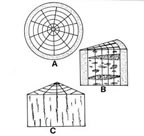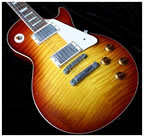| |
Introduction
As Les Paul aficionados, we are in love with the sound AND the beauty
of our guitars. And at the Les Paul Forum, a lot of the conversation and
photos posted relate to the beauty of the figured maple tops on our beloved
instruments. But do we know much about how the “figure” in
figured maple originates? I “figured” you didn’t!
|
| |
|
|
|
There
are many members of the Les Paul Forum, some of which are luthiers, woodworkers,
foresters, botanists, and self-proclaimed experts on wood. I am a neophyte
when it comes to the study of wood, but was curious enough to review several
articles and to liberally paraphrase them and “borrow with pride.”
So think of this article as a “CliffsNotes” version of what
I’ve reviewed for your convenience, sprinkled with a few pieces of
eye candy.
|
| |
Overview
Figured wood has been sought and worshipped for its beauty for centuries.
Any design, pattern, or distinctive mark that appears on the surfaces of
wood may be described as figure, and it results from combinations of color,
luster, texture, and grain. |
| |
|
|
|
Even
though it has been studied for a long time, very little is known about why
figure develops in wood. There are a lot of contradictory theories, and
the ultimate causes are largely unknown. Ecological factors have been studied
to see if they have an affect on figure, but there are no studies that have
shown a definitive correlation of factors like geographic location, climate,
soil, bark, foliage, rate of growth, etc. on figure. Most of the best figured
wood develops in well formed, straight, healthy trees. All figured wood
types occur in almost every part of the world where figure is recognized,
although certain areas appear to produce more figured trees than other areas.
|
| |
Categories of Figure
There are three broad types of figure, including “normal figure”
(texture variation showing growth layers, knots, etc.), “pigment figure,”
and “specific figure,” which results from the non-vertical alignment
of longitudinal fibers in the wood. Specific figure can be hidden or enhanced
by cutting methods, such as quarter sawn, flat (plain) sawn, etc.
|
 |
A. Transverse
B. Radial
C. Tangential |
Figure
occurs in living trees primarily as variations or distortions in the vertical
alignment of grain in either radial or tangential directions that result
in common figure types known as stripe, blister, curl, wavy, and several
other variations. Commercially usable figure is seldom found in trees less
than ten inches in diameter. Once it starts, it becomes more pronounced
in subsequent growth rings. Wavy grain is quite common near limbs and roots,
where it is localized in small areas. |
|
The kind of wood we Les Paul lovers like the best is from “undulating
growth.” Some is wavy in the radial plane while some is wavy in
the tangential plane. The cause of undulating growth is traced to the
method of cell division and enlargement. Undulating growth appears to
the viewer as an optical illusion of movable stripes or contrasting patches
of light and dark areas resulting from the fibrous structure. Figure caused
by undulating grain in wood is similar to striations formed in certain
gemstones. Figure is also a result, in part, of an interference pattern
produced by light rays striking the fine, undulating fibrous elements
contained within figured wood.
|
| |
|
|
|
When
the radial surface of wood exhibits wavy growth or grain, the tangential
face is smooth and the wavy or undulating grain can be observed, but is
not evident to the touch. When a wood section with curly grain is split,
it separates along the rays and along the wavy grain and is exhibited as
a corrugated surface that can be seen and felt on the radial surface. Undulating
growth is the result of elongation of individual cells that are initiated
at the same time which are somewhat delayed, resulting in some that are
longer than others.
|
| |
 |
|
|
| Curly
Maple Top
1999 Aged Murphy R9 |
Quartersawn
Fiddleback Top
1980 One-off Les Paul
|
Curly
Maple Top
1998 LP '58 Historic |
|
Curly/Fiddleback Maple
|
|
Wavy grain is called “curly” when waves can be measured in
terms of numbers per foot and “fiddleback” when waves are
measured in numbers per inch. True fiddleback is restricted to uniform,
straight-grained wood of high quality; curly woods frequently exhibit
sloping grain. Trees are tested for evidence of curly/fiddleback grain
by chipping away the bark and examining the inner wood.
Wood with
curly or fiddleback figure commonly is cut in a manner to display a radial
surface, which would be corrugated if the wood had been split. Appearing
on smooth surfaces in place of waves are series of alternately bright
and dark stripes that shade into one another and produce an illusion of
actual waves. Change in brightness result from differential light reflection.
Relatively high absorption by exposed fiber ends produces dark bands;
reflection and diffraction from fiber walls cause bright bands. Because
the fiber walls are curved sharply and act as concave or convex reflecting
surfaces, any change in angle or view or incident light makes the apparent
waves seem to shift.
When cut
on the true quarter, fiddleback figure will show as a series of straight,
evenly spaced, horizontal or slightly canted stripes. When cut slightly
off true quarter, these stripes may appear wavy or branched.
|
| |
| |
|
|
| Quilted
Top
1980 Jimmy Wallace |
One
Piece Quilted Top
1983 One-off
|
Quilted
Top
1982 Standard 82 |
| |
|
|
| Quilted
Maple |
For quilted figure, the grain affects the tangential surface instead of
the radial surface of the wood. To develop quilted figure, lumber must be
flat sawn, and veneer rotary cut, because the figure occurs on the tangential
face. Both lumber and veneer with quilted figure differ from other figure
types in that the front, or outside face, shows an apparent series of mounds
(convex areas) where the back face shows a similar series of concave or
depressed areas. Well- developed quilted and curly figures seldom occur
in the same tree.
|
| |
 |
Birdseye
Maple |
|
When trees exhibit reduced growth in localized circular areas that continue
year after year in the same location, it results in circular depressions,
or indented growth rings. When these identations create less numerous localized,
conical depressions that are large and deep, the wood is called “birdseye.”
Birdseye was previously thought to be associated with suppression or some
type of mechanical damage to the tree, but this has been proven to be incorrect.
|
| |
Well, that’s it! I hope that this summary is helpful to LPF members
as they admire the beautiful maple tops on their guitars. We are blessed
to have the gift of nature and the gorgeous wood it has bestowed upon us! |
| |
|
|
|
| NOTE:
As a member of the Les Paul Forum, I am always interested in learning
new things about the details and history of Gibson Guitars. Thus, I appreciate
any additional information or questions that readers may have about wood
or any other Gibson model. Please contact me at MikeSlub@aol.com.
Credit
is given for the extensive number of direct references from “Figure
in Wood: An Illustrated Review” by Harold O. Beals and Terry C.
Davis, Auburn University, January 1977, and other Internet search references
on figure in wood.
Mike
Slubowski is a Gibson enthusiast, collector, player, and author, with
a special passion for Les Pauls.
This
article and photos are property of Mike Slubowski. No part of this article
may be reproduced without the expressed written permission of the author. |